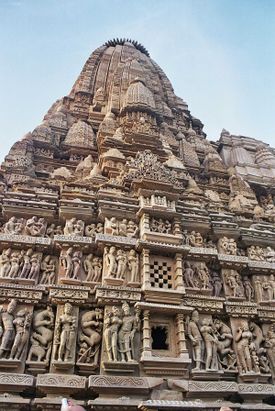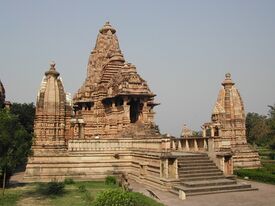Khajuraho Group of Monuments
| UNESCO World Heritage Site | |
|---|---|
 | |
| Criteria | Cultural: i, iii |
| Reference | 240 |
| Inscription | 1986 (10th session) |
Khajuraho (Template:Lang-hi) is a village in the Indian state of Madhya Pradesh, located in Chhatarpur District, about 385 miles (620 kilometres) southeast of Delhi, the capital city of India.
The Khajuraho group of monuments has been listed as a UNESCO World Heritage Site.
One of the most popular tourist destinations in India, Khajuraho has the largest group of medieval Hindu and Jain temples, famous for their erotic sculpture. The name Khajuraho, ancient "Kharjuravahaka", is derived from the Sanskrit word kharjur meaning date palm.
History
In the 27th century of Kali yuga the Mlechcha invaders started attacking North India some Bargujar Rajputs moved towards east to central India, they ruled over North-Eastern region of Rajasthan called Dhundhar and were referred to as Dhundhel/Dhundhela in ancient times, for the region they governed. Later on they called themselves Bundelas and Chandelas those who were in the ruling class having gotra Kashyap were definitely all Bargujars they were vassals of Gurjara - Pratihara empire of North India which lasted from 500 C.E. to 1300 C.E. and was at its peak when major monuments were built. The Bargujars also built the Kalinjar fort and Neelkanth Mahadev temple similar to one at Sariska National Park and Baroli, being Shiva worshipers. The city was the cultural capital of Chandela Rajputs, a Hindu dynasty that ruled this part of India from the 10th to the 12th centuries. Political capital of Chandelas was Kalinjar. The Khajuraho temples were built over a span of 200 years, from 950 to 1150. The Chandela capital was moved to Mahoba after this time, but Khajuraho continued to flourish for some time. Khajuraho has no forts because the Chandel Kings never lived in their cultural capital.
The whole area was enclosed by a wall with eight gates, each flanked by two golden palm trees. There were originally over 80 Hindu temples, of which only 25 now stand in a reasonable state of preservation, scattered over an area of about 8 square miles (21 km²).
The temples of Khajuraho suffered destruction by early Muslim invaders between c. 1100-1400 AD as various disfigured statues at the temple complex attest. Today, the temples serve as fine examples of Indian architectural styles that have gained popularity due to their explicit depiction of the traditional way of sexual life during medieval times. Locals living in the Khajuraho village always knew about and kept up the temples as best as they could. They were pointed out to an English man in late 19th century and the jungles had taken a toll on all of the monuments.
Geography
Khajuraho is located at Lua error: callParserFunction: function "#coordinates" was not found..[1] It has an average elevation of 283 metres (928 feet).
Demographics
Template:Infobox Indian Jurisdiction
As of 2001[update] India census,[2] Khajuraho had a population of 19,282. Males constitute 52% of the population and females 48%. Khajuraho has an average literacy rate of 53%, lower than the national average of 59.5%: male literacy is 62%, and female literacy is 43%. In Khajuraho, 19% of the population is under 6 years of age.
Architecture
The Khajuraho temples, constructed with spiral superstructures, adhere to a northern Indian shikhara temple style and often to a Panchayatana plan or layout. A few of the temples are dedicated to the Jain pantheon and the rest to Hindu deities - to God's Trio, Brahma, Vishnu and Shiva, and various Devi forms, such as the Devi Jagadambi temple. A Panchayatana temple had four subordinate shrines on four corners and the main shrine in the center of the podium, which comprises their base. The temples are grouped into three geographical divisions: western, eastern and southern.
With a graded rise secondary shikharas (spires) cluster to create an appropriate base for the main shikhara over the sanctum. Kandariya Mahadeva, one of the most accomplished temples of the Western group, comprises eighty-four shikharas, the main being 116 feet from the ground level.
The Khajuraho temples are made of sandstone, they didn't use mortar the stones were put together with mortise and tenon joints and they were held in place by gravity. This form of construction requires very precise joints. The columns and architraves were built with megaliths that weighed up to 20 tons. [3]

These shikharas – subordinate and main – attribute to the Khajuraho temples their unique splendor and special character. With a graded rise of these shikharas from over the ardhamandapa, porch, to mandapa, assembly hall, mahamandapa, principal assembly hall, antarala, vestibule, and garbhagriha, sanctum sanctorum, the Khajuraho temples attain the form and glory of gradually rising Himalayan peaks. These temples of Khajuraho have sculptures that look very realistic and are studied even today.
The Saraswathi temple on the campus of Birla Institute of Technology and Science, Pilani, India is modeled after the Khajuraho temple.
Landscape
The Khajuraho temples are now set in a parkland landscape. The archaeological park now has something of the character of an English public park, with mown grass, rose beds and ornamental trees. The development of landscape archaeology as an academic discipline raises questions concerning the earlier landscape of Khajuraho and the original relationship between the temple complex and the surrounding area. There are no records of what the original landscape might have been, but it is known that a large community of priests used the temple complex and that Indian gardens in the tenth century were predominantly tree gardens. They did not have lawns or herbaceous flowering plants.
Tourism
Khajuraho temple complex offers a well made light and sound show every evening. The first show is in English language and the second one in Hindi. The show is about an hour long and covers the history, philosophy and the art of sculpting of these temples. It is held in the open lawns in the temple complex.
Recent Discovery
Archaeological Survey of India has recently started dig on a mound where perhaps the largest underground temple in Khajuraho has been unearthed. The dig will take at least a couple of years to conclude.[citation needed]
See also
- Kandariya Mahadeva
- Hemvati
- Kalinjar
- Beejamandal
- Jain temples of Khajuraho
- List of megalithic sites
- Madhya Pradesh
References
- ↑ Falling Rain Genomics, Inc - Khajuraho
- ↑ Template:GR
- ↑ "Lost Worlds of the Kama Sutra" History channel
Central India Travel Guide - Khajuraho
Further reading
- Phani Kant Mishra, Khajuraho: With Latest Discoveries, Sundeep Prakashan (2001) ISBN 8175741015
- Devangana Desai, The Religious Imagery of Khajuraho, Franco-Indian Research P. Ltd. (1996) ISBN 81-900184-1-8
- Devangana Desai, Khajuraho, Oxford University Press Paperback (Sixth impression 2005) ISBN 978-0-19-565643-5
External links
- UNESCO World Heritage Site listing
- Khajuraho Temple Sculpture and Carvings Research Project & Photo Exhibition
- Photos about Khajuraho in the website of Italian writer Manuel Olivares
- Gallery of Khajuraho photos
- 100 photos 1280x960 of Khajuraho
- Template:Wikitravel
- Beauty of Khajuraho Temples
- Photos of the Khajuraho temple complex
- The Facts of Khajuraho
bn:খাজুরাহো cs:Khadžuráho de:Khajuraho es:Khajuraho eo:Khaĝuraho fr:Khajurâho hi:खजुराहो bpy:খাজুরাহ it:Khajuraho kn:ಖಜುರಾಹೊ ka:ქაჯურაჰო hu:Khadzsuráhó ml:ഖജുരാഹോ mr:खजुराहो nl:Khajuraho new:खजुराहो ja:カジュラーホー pl:Khajuraho pt:Conjunto de Templos de Khajuraho ru:Кхаджурахо fi:Khajuraho sv:Khajuraho te:ఖజురహో వద్ద నిర్మాణ సమూహాలు vi:Khajuraho zh:克久拉霍古跡群
- Articles needing cleanup
- Pages using infobox UNESCO World Heritage Site with unknown parameters
- Articles containing potentially dated statements from 2001
- Articles with invalid date parameter in template
- All articles containing potentially dated statements
- All articles with unsourced statements
- Articles with unsourced statements from April 2009
- Pages with broken file links
- Commons category link is locally defined
- Hindu World Heritage Sites
- Cities and towns in Madhya Pradesh
- Hindu holy cities
- Bundelkhand
- Tourism in Madhya Pradesh
- Chhatarpur
